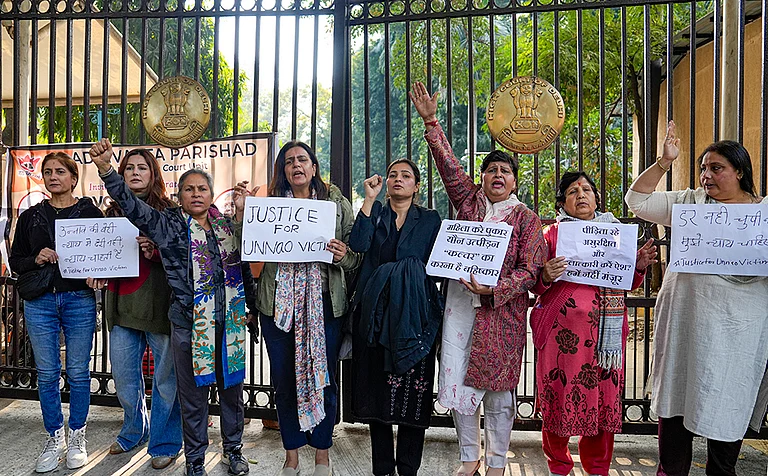Fareeda is one of the 3.5 lakh artisans in the state of Jammu and Kashmir who have started reaping the benefits of the Prime Minister’s package for handicraft development in the state that was introduced in the last financial year after former PM Atal Behari Vajpayee visited the Valley. Called the Ambedkar Hast Shilp Vikas Yojana, the package has the twin objectives of generating more employment in the handicrafts sector, and making products competitive enough to enter the world market. The scheme, according to Tinoo Joshi, development handicrafts commissioner, "aims at upgrading the production capacity, product diversification and reaching higher market segments". It also wants to resurrect ancient crafts like kaani (weaving shawls with twigs) that have suffered neglect over the last 14 years. The state has 32 recognised handicrafts, and according to the current figures, it is producing handicrafts worth Rs 800 crore every year and exporting to the tune of Rs 500 crore per year. Considering the production potential is Rs 1,500 crore, there’s a lot more to be done.

The PM’s package—with a series of short-term and long-term interventions—hopes to go some way in achieving this turnaround. A self-help group is a short-term intervention in which one artisan hires some more artisans and the group manages everything, from procurement of raw material to sale of the goods. At the moment, 202 self-help groups covering 2,020 artisans are at work in the Valley. Long-term interventions include construction of a Crafts Design Institute and an Institute of Carpet Technology near Srinagar. "These institutes aim at consolidating and professionalising the traditional crafts of the state," says R.A, Quadri, director, handicrafts, J&K government.
While reviving the crafts, the package simultaneously wants to find them the markets. Militancy in the Valley had ensured that international buyers stopped coming following their government’s travel advisories. Domestic buyers too gave the state a go-by in their itineraries during its period of strife. By facilitating the participation of Kashmiri artisans in national and international handicrafts fairs, the government has been trying to change that.
With better marketing options therefore, a lot of artisans are looking to increase their production. To aid that, the government gives Rs 20,000 to the rural artisan and Rs 22,000 to an urban one for constructing worksheds. Yet another small-term intervention, it has enabled the creation of 968 worksheds. But Ghulam Nabi Najam, a walnut wood artisan, considers the sum of Rs 11,000 at a time less. "We have to add Rs 10,000-20,000 of our own to get the work started." Others are finding it difficult to open a bank account. As per the guidelines in the scheme, an artisan should have an account in a nationalised bank to avail of the financial benefits. But Syed Abrar Hussain, a papier mache manufacturer, has been trying to open an account in Punjab National Bank, Hawal, Srinagar, for the last three months and seems to think the bank is harassing him needlessly despite the fact that he has fulfilled all requirements. But officers believe these are just teething troubles that will sort themselves out once the profits start coming in.
Meanwhile, another area the scheme is gearing up to address is in the sourcing of raw material. Kashmir’s years of insurgency had turned this into a problem too. The scheme aims to develop a raw material bank. The Government of India has already given Rs 1 crore to the Small Industries Development Corporation to procure 12,000 kg of spun silk for the carpet industry. To make the artisans self-reliant, the government is setting up four common facility centres in Srinagar that will cater to the demands of raw material and mechanised processes like carpet drying, washing and wood seasoning.

Perhaps the most important intervention the scheme seeks to make is by organising the interaction of the local craftsmen with designers from outside the state. The invited designers are from institutes like nid in Ahmedabad and NIFT in New Delhi, and are on the textiles ministry panel. Last year, 20 design workshops were organised. And currently, 12 integrated projects, more comprehensive and longer, are being implemented. Rohit Kumar, an NIFT graduate, is on one such project. He is guiding copperware artisans in developing newer designs. "I have suggested that they minimise the detailing on household goods as per the current market trends," he says. He prefers to keep the technique as traditional as possible and only innovate in design, proportion and sizes. Vibhor Sogani, an nid graduate, too has been working with copper artisans. He has innovated on the shape of the samovar and made it conical. The design is inspired from a similarly shaped kettle designed by international brand Alessi that’s available at their showroom in Delhi.

Each project results in the production of 25 prototypes, which are then exhibited at national and international fairs. Last year, the state participated in four international fairs held in Delhi, two in Germany, one in Birmingham and one in Dubai. Shabir Ali Beigh, a Sozni artiste, had the opportunity to practically demonstrate his craft in Germany. "The experience was overwhelming, people over there found it hard to believe that such intricate work could be done with hands," he says.
But Ali Mohammad, Shabir’s father and a national awardee, cannot share all of his son’s excitement. "I’m 65 years old, my eyes are getting weak, yet in order to sustain myself I have to sit for hours, working so minutely with the needle," he says. To help older artisans like him, he wants the government to start a pension scheme. For walnut wood artisan Najam, participating in international fairs is all too fine, but to do so, the artisan first has to shell out Rs 20,000-30,000 as entry fee. "We take a loan from banks but the interest rate of 12 per cent is very high for us," he says.
Be that as it may, the PM’s package is making a difference at the grassroots. Since the launch of the scheme, more than 12,000 artisans have been provided with employment, something they haven’t seen in a long time and more than 3,000 have benefited from financial assistance. As Fareeda’s father says, "Now that both me and my daughter are earning, our condition of living is better. More important, my daughter too has learnt the craft and it will live even after I die."


























